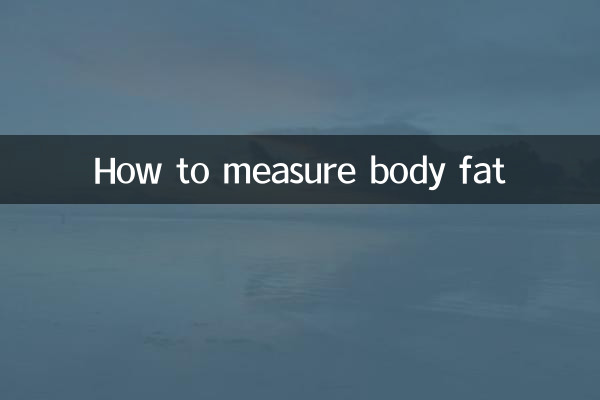How to Measure Body Fat: A Scientific Method and a Practical Guide
Body fat rate is one of the important indicators to measure physical health. It reflects the proportion of body fat. In recent years, with the increase in health awareness, measuring body fat has become the focus of many people's attention. This article will introduce several common body fat measurement methods in detail and provide structured data comparison to help you choose the most suitable method.
1. Common body fat measurement methods

The following is a comparison of the current mainstream body fat measurement methods and their advantages and disadvantages:
| Measurement method | Principle | Advantages | Disadvantages | Suitable for the crowd |
|---|---|---|---|---|
| Skinfold thickness measurement | Measure subcutaneous fat thickness with calipers | Low cost and simple operation | Accuracy depends on operator experience | Fitness enthusiasts, general population |
| Bioelectrical Impedance Method (BIA) | Utilizing the difference in resistance between current passing through fat and muscle | Fast and non-invasive | Greatly affected by water intake | Home users, gym |
| underwater weighing method | Calculate body fat percentage from underwater weight | Higher accuracy | Complex operation and requires specialized equipment | Athletes, researchers |
| Dual-energy X-ray absorptiometry (DEXA) | Scan the whole body with X-rays | Accurate results and measurable bone density | High cost and radiation | Medical institutions, professional athletes |
| 3D body scan | Modeling via infrared or camera | Intuitive and measurable changes in body shape | Equipment is expensive | High-end gyms and scientific research institutions |
2. How to choose the measurement method that suits you
1.Limited budget: Skinfold thickness measurement or an at-home body fat scale (BIA) are affordable options.
2.pursuit of accuracy: DEXA or underwater weighing method is more suitable, but you need to go to a professional institution.
3.Long term tracking: It is recommended to use the same measurement method to reduce errors.
3. Things to note when measuring body fat
1.Measurement time: It is recommended to measure on an empty stomach in the morning to avoid the influence of diet and exercise.
2.Measurement frequency: 1-2 times a week is sufficient. Too frequent may cause data fluctuations.
3.Data interpretation: Body fat percentage standards vary by age and gender. The following is the reference range:
| crowd | healthy range | obesity threshold |
|---|---|---|
| adult male | 10-20% | >25% |
| adult women | 18-28% | >32% |
| athlete | Male 6-13% Female 14-20% | - |
4. Scientific suggestions for reducing body fat rate
1.Eat properly: Control total calorie intake and increase protein and dietary fiber.
2.aerobics: 3-5 times a week, moderate to high-intensity exercise for more than 30 minutes each time.
3.strength training: Increasing muscle mass helps increase basal metabolic rate.
4.Get enough sleep: Lack of sleep can affect hormone balance and lead to fat accumulation.
5. Summary
Measuring body fat is an important part of health management. Choosing an appropriate method and keeping track can help you better understand your physical condition. Whether it is a simple home body fat scale or a professional DEXA scan, the key lies in the continuity of the data and the scientific interpretation. Combined with a healthy lifestyle, you're sure to reach your ideal body fat goals.
Remember, body fat rate is only one aspect of health. There is no need to pursue low values excessively. Balanced development is the real way to health.

check the details

check the details